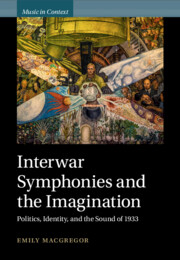Book contents
- Interwar Symphonies and the Imagination
- Music in Context
- Interwar Symphonies and the Imagination
- Copyright page
- Dedication
- Contents
- Figures
- Examples
- Preface
- Acknowledgements
- Abbreviations
- 1 Between Europe and America: Kurt Weill’s Symphony in a Suitcase
- 2 Listening for the Intimsphäre in Hans Pfitzner’s Symphony in C♯ Minor
- 3 Liberalism, Race, and the American West in Roy Harris’s Symphony 1933
- 4 Aaron Copland’s and Carlos Chávez’s Pan-American Bounding Line
- 5 Arthur Honegger’s ‘Modernised Eroica’
- 6 The Right Kind of Symphonist: Florence Price and Kurt Weill
- Select Bibliography
- Index
3 - Liberalism, Race, and the American West in Roy Harris’s Symphony 1933
Boston – New York
Published online by Cambridge University Press: 28 January 2023
- Interwar Symphonies and the Imagination
- Music in Context
- Interwar Symphonies and the Imagination
- Copyright page
- Dedication
- Contents
- Figures
- Examples
- Preface
- Acknowledgements
- Abbreviations
- 1 Between Europe and America: Kurt Weill’s Symphony in a Suitcase
- 2 Listening for the Intimsphäre in Hans Pfitzner’s Symphony in C♯ Minor
- 3 Liberalism, Race, and the American West in Roy Harris’s Symphony 1933
- 4 Aaron Copland’s and Carlos Chávez’s Pan-American Bounding Line
- 5 Arthur Honegger’s ‘Modernised Eroica’
- 6 The Right Kind of Symphonist: Florence Price and Kurt Weill
- Select Bibliography
- Index
Summary
Chapter 3 shifts the focus to the US East Coast. Roy Harris was one of several young Americans who studied composition in Paris with Nadia Boulanger in the 1920s; Symphony 1933 was his breakthrough work after returning home. Commissioned by Serge Koussevitzky, who anecdotally asked for a ‘big symphony from the West’, Symphony 1933 teases out the relationships between those expansionist discourses associated with the symphony indicated by Paul Bekker (1918), liberal ideology, and the imagined spaces of the American West. Examining the reception of Symphony 1933 and its music, the chapter raises questions about how the discourse around Harris’s symphony and liberalism’s spatial narratives colluded in establishing the political hegemony of white Americans and the supposed naturalness of their right to occupy the West, an acute anxiety given the disenfranchisement of white working-class Americans during the economic collapse of the early 1930s.
- Type
- Chapter
- Information
- Interwar Symphonies and the ImaginationPolitics, Identity, and the Sound of 1933, pp. 83 - 113Publisher: Cambridge University PressPrint publication year: 2023

